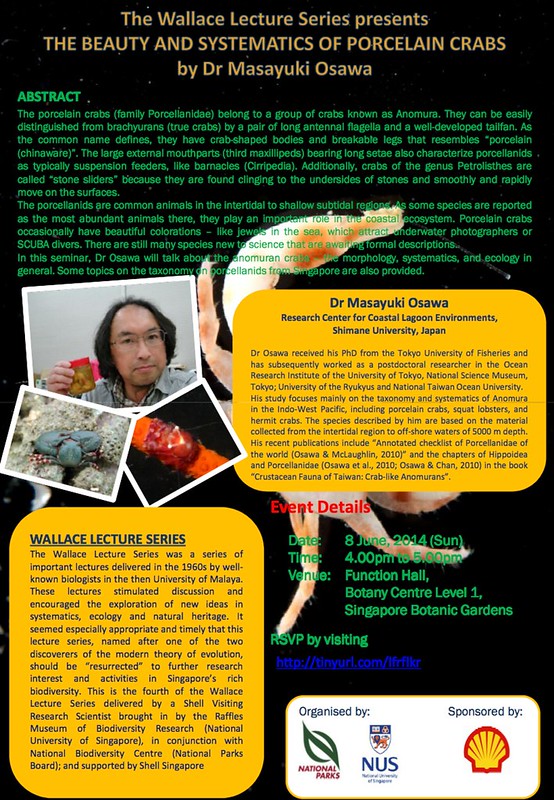Month: June 2014
Mon 30 Jun 2014: 4.00pm @ DBS CR – WIlliam F. Laurance on “A global strategy for road building”
Butterfly ‘eyespot’ research by Antónia featured on ScienceDaily
Congratulations to Associate Professor Antónia Monteiro and colleagues on the publication of their latest paper, “Nymphalid eyespot serial homologues originate as a few individualized modules” in the Proceedings of The Royal Society B.
The paper was highlighted on ScienceDaily in “Butterfly ‘eyespots’ add detail to story of evolution“. The first author, Jeffrey Oliver, a postdoctoral scholar in the Department of Integrative Biology of the Oregon State University College of Science stated that the study indicated how continued mutations allowed eyeposts to move to different positions on the wings to perform a different function from its original placement. With the help of butterfly eyespots, we are inching closer to understand the existence of serial homologues and even the fundamentals of evolution.
For full citation: J. C. Oliver, J. M. Beaulieu, L. F. Gall, W. H. Piel, A. Monteiro. Nymphalid eyespot serial homologues originate as a few individualized modules. Proceedings of the Royal Society B: Biological Sciences, 2014; 281 (1787): 20133262 DOI: 10.1098/rspb.2013.3262
Tai Chong’s paper in PLOS ONE highlighted by EurekAlert
Congratulations to Toh Tai Chong and colleagues from the Reef Ecology Lab.
 Tai Chong’s recent work on “Augmenting the Post-Transplantation Growth and Survivorship of Juvenile Scleractinian Corals via Nutritional Enhancement” has been published in PLOS ONE.
Tai Chong’s recent work on “Augmenting the Post-Transplantation Growth and Survivorship of Juvenile Scleractinian Corals via Nutritional Enhancement” has been published in PLOS ONE.
The journal article has also been reported by Kayla Graham on the international scientific news website EurekAlert in “Feeding increases coral transplant survival“.
What do these results mean? Tai Chong suggested that “the results have underlined the feasibility of feeding juvenile corals as a supplementary measure to enhance coral transplant survival on the reef, and this could be applied to both aquaculture and restoration efforts.”
Full citation: Toh TC, Ng CSL, Peh JWK, Toh KB, Chou LM (2014) Augmenting the Post-Transplantation Growth and Survivorship of Juvenile Scleractinian Corals via Nutritional Enhancement. PLoS ONE 9(6): e98529. doi:10.1371/journal.pone.0098529
Sun 08 Jun 2014: 4.00pm @ SBG Botany Centre – “The Beauty and Systematics of Porcelain Crabs,” by Masayuki Osawa (Wallace Lecture Series)
 The Wallace Lecture Series presents
The Wallace Lecture Series presents
The Beauty and Systematics of Porcelain Crabs
Dr Masayuki Osawa
Research Center for Coastal Lagoon Environments,
Shimane University, Japan
Sunday 8th June 2014
4.00pm – 5.00pm
Function Hall,
Botany Centre Level 1,
Singapore Botanic Gardens
(Tanglin Gate)
Register here please: tinyurl.com/wls-porcelaincrabs
About the talk – The porcelain crabs (family Porcellanidae) belong to a group of crabs known as Anomura. They can be easily distinguished from brachyurans (true crabs) by a pair of long antennal flagella and a well-developed tailfan. As the common name defines, they have crab-shaped bodies and breakable legs that resembles “porcelain (chinaware)”. The large external mouthparts (third maxillipeds) bearing long setae also characterize porcellanids as typically suspension feeders, like barnacles (Cirripedia). Additionally, crabs of the genus Petrolisthes are called “stone sliders” because they are found clinging to the undersides of stones and smoothly and rapidly move on the surfaces.
The porcellanids are common animals in the intertidal to shallow subtidal regions. As some species are reported as the most abundant animals there, they play an important role in the coastal ecosystem. Porcelain crabs occasionally have beautiful colorations – like jewels in the sea, which attract underwater photographers or SCUBA divers. There are still many species new to science that are awaiting formal descriptions.
In this seminar, Dr Osawa will talk about the anomuran crabs – the morphology, systematics, and ecology in general. Some topics on the taxonomy on porcellanids from Singapore are also provided.
About the speaker – Dr Osawa received his PhD from the Tokyo University of Fisheries and has subsequently worked as a postdoctoral researcher in the Ocean Research Institute of the University of Tokyo, National Science Museum, Tokyo; University of the Ryukyus and National Taiwan Ocean University. His study focuses mainly on the taxonomy and systematics of Anomura in the Indo-West Pacific, including porcelain crabs, squat lobsters, and hermit crabs. The species described by him are based on the material collected from the intertidal region to off-shore waters of 5000 m depth. His recent publications include “Annotated checklist of Porcellanidae of the world (Osawa & McLaughlin, 2010)” and the chapters of Hippoidea and Porcellanidae (Osawa et al., 2010; Osawa & Chan, 2010) in the book “Crustacean Fauna of Taiwan: Crab-like Anomurans”.
About the Wallace Lecture Series
The Wallace Lecture Series was a series of important lectures delivered in the 1960s by well- known biologists in the then University of Malaya. These lectures stimulated discussion and encouraged the exploration of new ideas in systematics, ecology and natural heritage. It seemed especially appropriate and timely that this lecture series, named after one of the two discoverers of the modern theory of evolution, should be “resurrected” to further research interest and activities in Singapore’s rich biodiversity.
This is the fourth of the Wallace Lecture Series delivered by a Shell Visiting Research Scientist brought in by the Lee Kong Chian natural History Museum (National University of Singapore), in conjunction with National Biodiversity Centre (National Parks Board); and supported by Shell Singapore.
Job: Research Assistant for seven month population genetics study
Job: Research Assistant for seven month population genetics study
We are recruiting an enthusiastic research assistant to participate in ongoing projects in population genetics.
This position is primarily laboratory based, and the candidate should have a minimum of a Bachelor degree in science with skills and experience in basic molecular techniques. This position is a joint appointment with NUS and the Wildlife Conservation Society for 7 months.
The salary will be commensurate with experience and previous research accomplishments.
Interested candidates should send a cover letter or email, CV, and two recommendation letters to Theo Evans (dbseta@nus.edu.sg).


